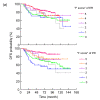Fractionated evaluation of immunohistochemical hormone receptor expression enhances prognostic prediction in breast cancer patients treated with tamoxifen as adjuvant therapy
- PMID: 20043345
- PMCID: PMC2801083
- DOI: 10.1631/jzus.B0900295
Fractionated evaluation of immunohistochemical hormone receptor expression enhances prognostic prediction in breast cancer patients treated with tamoxifen as adjuvant therapy
Abstract
Objective: To compare the prognostic prediction between dichotomized and fractionated evaluations of hormone receptor expressions.
Methods: Patients with stages I-III breast cancers, who received adjuvant tamoxifen, were enrolled. The expression of estrogen receptor (ER) and progesterone receptor (PR) was evaluated by immunohistochemistry (IHC). A fractionated score (F score), the percentage of positive-staining nuclei (0=none, 1=1%-10%, 2=11%-30%, 3=31%-50%, 4=51%-70%, and 5=71%-100%), was assigned to each case. The dichotomized scoring method defines an F score >1 as positive. The prognostic values of both scores were compared by multiple Cox's proportional hazard models of disease-free survival (DFS) and overall survival (OS).
Results: Four hundred and sixteen patients with a median follow-up of 78.0 months were included. F scores for ER and PR correlated directly with DFS and OS. Although both the dichotomized and fractionated ER and PR scores were significantly associated with DFS and OS in univariate analyses, only fractionated ER and PR scores remained as independent prognostic factors of DFS and OS in the final multiple Cox's proportional hazard models.
Conclusion: Fractionated IHC hormone receptor expression evaluation enhances the prognostic prediction compared with a dichotomized assessment.
Figures









Similar articles
-
Estrogen receptor-positive, progesterone receptor-negative breast cancer: association with growth factor receptor expression and tamoxifen resistance.J Natl Cancer Inst. 2005 Sep 7;97(17):1254-61. doi: 10.1093/jnci/dji249. J Natl Cancer Inst. 2005. PMID: 16145046
-
Progesterone receptor is a significant factor associated with clinical outcomes and effect of adjuvant tamoxifen therapy in breast cancer patients.Breast Cancer Res Treat. 2010 Jan;119(1):53-61. doi: 10.1007/s10549-009-0318-0. Epub 2009 Feb 10. Breast Cancer Res Treat. 2010. PMID: 19205877
-
High progesterone receptor expression correlates to the effect of adjuvant tamoxifen in premenopausal breast cancer patients.Clin Cancer Res. 2006 Aug 1;12(15):4614-8. doi: 10.1158/1078-0432.CCR-06-0248. Clin Cancer Res. 2006. PMID: 16899609
-
Absent progesterone receptor expression in the lymph node metastases of ER-positive, HER2-negative breast cancer is associated with relapse on tamoxifen.J Clin Pathol. 2017 Nov;70(11):954-960. doi: 10.1136/jclinpath-2016-204304. Epub 2017 Apr 17. J Clin Pathol. 2017. PMID: 28416639
-
Prognostic significance of bcl-2 expression in stage III breast cancer patients who had received doxorubicin and cyclophosphamide followed by paclitaxel as adjuvant chemotherapy.BMC Cancer. 2007 Apr 12;7:63. doi: 10.1186/1471-2407-7-63. BMC Cancer. 2007. PMID: 17430582 Free PMC article.
Cited by
-
Genetic polymorphisms of CYP2D6*10 and the effectiveness of combined tamoxifen citrate and testosterone undecanoate treatment in infertile men with idiopathic oligozoospermia.J Zhejiang Univ Sci B. 2015 Mar;16(3):191-7. doi: 10.1631/jzus.B1400282. J Zhejiang Univ Sci B. 2015. PMID: 25743120 Free PMC article.
-
Incorporating progesterone receptor expression into the PREDICT breast prognostic model.Eur J Cancer. 2022 Sep;173:178-193. doi: 10.1016/j.ejca.2022.06.011. Epub 2022 Aug 4. Eur J Cancer. 2022. PMID: 35933885 Free PMC article.
-
Polymorphisms of ESR1, UGT1A1, HCN1, MAP3K1 and CYP2B6 are associated with the prognosis of hormone receptor-positive early breast cancer.Oncotarget. 2017 Mar 28;8(13):20925-20938. doi: 10.18632/oncotarget.14995. Oncotarget. 2017. PMID: 28178648 Free PMC article.
-
A novel animal model for locally advanced breast cancer.Ann Surg Oncol. 2015 Mar;22(3):866-73. doi: 10.1245/s10434-014-4174-8. Epub 2014 Oct 18. Ann Surg Oncol. 2015. PMID: 25326397 Free PMC article.
References
-
- Arpino G, Weiss H, Lee AV, Schiff R, de Placido S, Osborne CK, Elledge RM. Estrogen receptor-positive, progesterone receptor-negative breast cancer: association with growth factor receptor expression and tamoxifen resistance. J Natl Cancer Inst. 2005;97(17):1254–1261. - PubMed
-
- Badve SS, Baehner FL, Gray RP, Childs BH, Maddala T, Liu ML, Rowley SC, Shak S, Perez EA, Shulman LJ, et al. Estrogen- and progesterone-receptor status in ECOG 2197: comparison of immunohistochemistry by local and central laboratories and quantitative reverse transcription polymerase chain reaction by central laboratory. J Clin Oncol. 2008;26(15):2473–2481. doi: 10.1200/JCO.2007.13.6424. - DOI - PubMed
Publication types
MeSH terms
Substances
LinkOut - more resources
Full Text Sources
Medical
Research Materials

